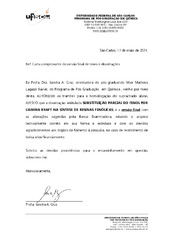| dc.contributor.author | Xavier, Vitor Matheus Lagazzi | |
| dc.date.accessioned | 2021-07-06T12:48:46Z | |
| dc.date.available | 2021-07-06T12:48:46Z | |
| dc.date.issued | 2021-02-26 | |
| dc.identifier.citation | XAVIER, Vitor Matheus Lagazzi. Substituição parcial do fenol por lignina Kraft na síntese de resinas fenólicas. 2021. Dissertação (Mestrado em Química) – Universidade Federal de São Carlos, São Carlos, 2021. Disponível em: https://repositorio.ufscar.br/handle/ufscar/14526. | * |
| dc.identifier.uri | https://repositorio.ufscar.br/handle/ufscar/14526 | |
| dc.description.abstract | In recent years, there has been a worldwide interest in the development of "green" technologies which enable the use of products with less environmental impact. There is an increasing focus in the use of raw materials obtained from biomass. The interest increases, mainly, when the biomaterial comes from some industrial waste. From this motivation, there has been the replacement of phenol by lignin for the production of phenolic resins. The used lignin came from the industrial paper and cellulose waste and extracted through the Kraft process. The aiming was reducing the dependence on phenol, a petroleum derivative, by developing a more sustainable product and increasing the value of lignin once, currently, this biopolymer is burned in boilers for power generation. Thus, lignin was used as a partial substitute for phenol in the condensation reactions of phenolic resins of the resole type, to produce lignin-phenol-formaldehyde adhesives for wood which do not have the distillation step in the manufacturing process. In order to identify the best polymerization parameters and find the highest percentage of mass substitution (lignin for phenol), factorial design was used. The resulting model indicated that the best replacement conditions and condensation time were approximately 15% and 75 minutes, respectively. Meanwhile and aiming industrial interest, maximum replacement percentage and shorter condensation time (less time spent in the reactor batch), the system was also studied with 20% replacement and 55 minutes of condensation. The physical-chemical properties of the synthesized adhesives were assessed by viscosity, solids content, gelatinization time (gel time) and mechanical strength of glued joints techniques, comparing them with the standard sample (100% phenol used in its synthesis, that is, without replacement) and the replaced samples. The results achieved in the physical-chemical analyses and mechanical strength of glued joints tests of the modified resins were similar or superior when compared with the pure resin. Once we had an increase in pressing time or an increase of the press temperature, we could possibly have obtained better mechanical strength of glued joints results for the experiment with a higher replacement percentage. Through the obtained results by differential scanning calorimetry of the three tested samples, it was possible to observe peculiar endothermic peaks from the reticulation process, we could suggest that the higher the percentage of replacement the higher the energy will be required for the crosslinking of the lignin-phenol-formaldehyde polymer, due to displacement of the curves to higher temperatures. Finally, it was concluded that it is possible to replace phenol up to 20%, having the required properties as a phenolic adhesive maintained. | eng |
| dc.description.sponsorship | Não recebi financiamento | por |
| dc.language.iso | por | por |
| dc.publisher | Universidade Federal de São Carlos | por |
| dc.rights | Attribution-NonCommercial-NoDerivs 3.0 Brazil | * |
| dc.rights.uri | http://creativecommons.org/licenses/by-nc-nd/3.0/br/ | * |
| dc.subject | Lignina | por |
| dc.subject | Resinas fenólicas | por |
| dc.subject | Polimerização | por |
| dc.subject | Lignin | eng |
| dc.subject | Phenolic resins | eng |
| dc.subject | Polymerization | eng |
| dc.title | Substituição parcial do fenol por lignina Kraft na síntese de resinas fenólicas | por |
| dc.title.alternative | Partial phenol replacement by Kraft lignin in the phenolic resin synthesis | eng |
| dc.type | Dissertação | por |
| dc.contributor.advisor1 | Cruz, Sandra Andrea | |
| dc.contributor.advisor1Lattes | http://lattes.cnpq.br/9632409046763256 | por |
| dc.description.resumo | Nos últimos anos tem surgido um interesse mundial no desenvolvimento de tecnologias “verdes” que possibilitem a utilização de produtos com menor impacto ambiental. O emprego de matérias-primas obtidas a partir de biomassa está cada vez mais em foco. O interesse aumenta, principalmente, quando o biomaterial é proveniente de algum rejeito do processo industrial. A partir dessa motivação, neste trabalho, realizou-se a substituição do fenol por lignina para a produção de resinas fenólicas. A lignina empregada foi oriunda do resíduo da indústria de papel e celulose e extraída através do processo Kraft. Almejou-se reduzir a dependência do fenol, um derivado do petróleo, desenvolvendo um produto mais sustentável e aumentando o valor agregado da lignina, visto que atualmente este biopolímero é queimado em caldeiras para geração de energia. Assim, a lignina foi utilizada como substituinte parcial do fenol nas reações de condensação de resinas fenólicas do tipo resol, para a produção de adesivos lignina-fenol-formaldeído utilizados na indústria moveleira, os quais não possuem a etapa de destilação no processo de fabricação. Com o intuito de identificar os melhores parâmetros da polimerização e encontrar a maior porcentagem mássica de substituição (lignina por fenol), fez-se o uso do planejamento fatorial. O modelo resultante indicou que as melhores condições de substituição e tempo de condensação foram aproximadamente 15% e 75 minutos, respectivamente. Em paralelo e visando o interesse industrial, máxima porcentagem substituição e menor tempo de condensação (menor tempo gasto da batelada no reator), estudou-se o sistema também com 20% de substituição e 55 minutos de condensação. Avaliou-se as propriedades físico-químicas dos adesivos sintetizados pelas técnicas de viscosidade, teor de sólidos, tempo de gelatinização (gel time) e resistência mecânica de juntas coladas, comparando-se com a amostra padrão (100% de fenol utilizada em sua síntese, ou seja, sem substituição) com as amostras substituídas. Os resultados obtidos nas análises físico-químicas e nos testes de resistência mecânica de juntas coladas das resinas modificadas foram semelhantes ou superiores quando comparados com a resina pura. Possivelmente melhores resultados dos testes de resistência mecânica de juntas coladas poderiam ter sido obtidos para o experimento com maior porcentagem de substituição se houvesse um acréscimo no tempo ou temperatura na etapa de prensagem. Através dos resultados obtidos por calorimetria diferencial exploratória das 3 amostras testadas, foi possível verificar picos endotérmicos característicos do processo de reticulação, sugere-se que quanto maior a porcentagem de substituição, maior será a energia necessária para a reticulação do polímero lignina-fenol-formaldeído, devido o deslocamento das curvas para temperaturas mais altas. Por fim, concluiu-se que é possível a substituição do fenol em até 20%, mantendo as propriedades requeridas como adesivo fenólico. | por |
| dc.publisher.initials | UFSCar | por |
| dc.publisher.program | Programa de Pós-Graduação em Química - PPGQ | por |
| dc.subject.cnpq | CIENCIAS EXATAS E DA TERRA::QUIMICA::QUIMICA ORGANICA::POLIMEROS E COLOIDES | por |
| dc.publisher.address | Câmpus São Carlos | por |
| dc.contributor.authorlattes | http://lattes.cnpq.br/4203853681499907 | por |


